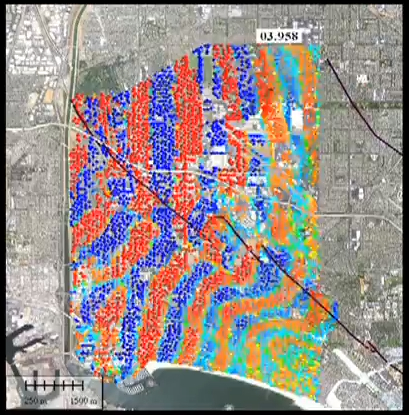A fairly unique study came out a few months ago in the journal Geology, in which the authors propose a novel mechanism of erosion: abrasion during earthquake shaking.
Seismicity and the strange rubbing boulders of the Atacama desert, northern Chile
The researchers were puzzled by fields of boulders sitting hardly buried atop the silty floor of Chile’s hyper-arid Atacama desert. They noted odd “moats” in broken silt crust around the boulders, and odd patterns of smoothing around only portions of the boulders’ sides. While they were out documenting these patterns they witnessed a M5.2 earthquake (centered 100km away) rock the landscape, swaying the boulders and producing a clattering roar as the rocks clapped into one another.

A boulder field in the barren Atacama desert displays evidence of clattering clasts, rubbed smooth by collisions during earthquakes. Photo by Jay Quade, hosted on http://www.geosociety.org
So… they proposed that shaking by the rather frequent Chilean earthquakes causes these rocks to rub each other, and over literally millions of years they wear each other smooth at their points of contact. A back-of-the-envelope calculation estimates that these rocks have shaken for up to 70,000 hours of their 1.3 million-year existences on this surface. That should be plenty of time to wear each other smooth, if it’s what’s really going on.
If you can read the article, note that I find their Figure 2E the most compelling, showing the abraded corner of one boulder sitting nestled into a conformable, abraded concavity on a neighboring boulder. Still, I’m not entirely convinced that the authors have ruled out wind-borne sand abrasion as a cause of much of this wear. Their main arguments against it are the localization of abrasion around the mid-sections of boulders (whereas wind-abraded ventifacts are presumably more thoroughly smoothed all around), and the broken silt crust in the moats, which would be expected to be homogeneous sand if the moats were formed by wind, with the finer silt blown away. Without more detailed documentation of the features, I’m not fully convinced that these uneven patterns of abrasion cannot still be explained by localized concentration of high-speed sand grains, concentrated in narrow gaps between boulders or low along the ground in the layer of heavy saltating grains.
That doubt expressed, I fully accept that their suggested mechanism is in fact an agent of boulder smoothing and erosion: they have anecdotal evidence that it occurs, and I think basic physics requires the rocking and colliding of these rocks, leading to thorough abrasion over repeated shaking through geologic time. Heck, there’s all kinds of evidence of boulder motion during quakes, from the bouncing pock marks I saw after the El Mayor Cucapah earthquake, to this classic toppled boulder in the Eastern Sierra.

Rocks loosened from the hillside during a M7.2 earthquake leave trails of divots where they bounced down into a wash.

The trail of a boulder, knocked during a M6 1980 earthquake from its perch atop a fault scarp, leads directly to the boulder in its resting place behind a camp site shell along McGee Creek, California.
Their final discussion makes some key points: 1) in most places on Earth, water, wind, and ice erosion act much more quickly than seismic events recur, meaning that any evidence of clattering rocks is overwhelmed and erased by the more efficient modes of erosion. 2) On barren, dry, rocky planets where water erosion does not occur, seismic abrasion may actually be a dominant mode of both smoothing and transport of clasts. In fact scientists earlier this year suggested this very notion based on photographic evidence from Mars, where fields of displaced boulders (with trails!) were concentrated around seismic fault lines.
What do you think? Are the smooth bands around the rocks explained by rubbing during earthquakes? We’ve seen weirder things….
 Big quakes in the past week
Big quakes in the past week









